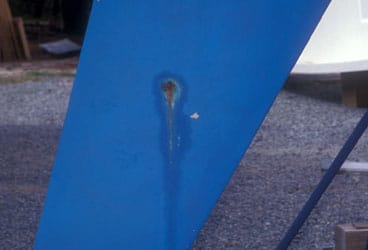
Rusty Rudder
Many conscientious cruisers aren’t sure when they should unship their sailboat rudder for inspection and what they should look for when they do. Like so many aspects of boat ownership, there are few hard and fast rules. Those based on the calendar or the number of miles traveled don’t take into account the design, construction materials, and climate or the preventive maintenance that’s already been carried out. Reliable steering, of course, is always a priority, but for vessels that venture offshore, the standard must necessarily be higher; rudder failure at sea can result in catastrophe.
A thorough inspection of the sailboat rudder while it’s in place can often yield clues to whether removal is the right approach. In many cases, the only portion of the rudder that can’t be easily inspected is the stock, where it passes through the trunk or log. Depending upon the design, removing the stuffing box from the trunk may enable the inspection of much of the stock, particularly where corrosion is most likely to occur, at the stuffing box’s packing. Here, wet packing remains in contact with the stock, which is nearly always a stainless-steel alloy. If the vessel remains dormant for long periods, as far too many do, the oxygen in the water contained within the trunk becomes depleted, which can lead to crevice corrosion of the stock, and this nearly always occurs directly beneath the packing or, if one is present, beneath a bearing.

| |The rudder’s stock-to-bearing interface should be inspected for excessive play or signs of rust, corrosion, or bearing debris.|
The area where the stock enters the blade is also worthy of close inspection. Mating such disparate materials as stainless steel and FRP or fiberglass produces a tenuous hold at best. In most cases, the bond between the two begins to separate early on in a rudder’s life; it’s a process that’s nearly unavoidable. Over time, water will often work its way down between these two components; if it’s a skeg-hung rudder, it may work up from the bottom. Once in this void, the oxygen in the water is depleted, once again becoming an ideal environment for crevice corrosion. And if the rudder’s armature, the metallic framework that supports the blade, is made from mild steel, as many are, then it, too, is susceptible to good old-fashioned oxidation or rust.
As disconcerting as this sounds, the good news is that telltale signs often indicate when trouble lurks beneath an otherwise seemingly unblemished FRP skin. Brown, rust-like stains are the product of crevice corrosion and rusting mild steel, and when you spot them on or beneath a sailboat rudder, they’re always cause for concern.
It’s possible to stem or retard entering water by caulking the interface between the stock and the FRP blade. Most polyurethane sealants won’t adhere to stainless steel for very long, so it may become a seasonal process; however, the effort is minimal, and the reward potentially great.
If the stock, blade, or supporting hardware, gudgeons, pintles, or hinges show any signs of deterioration, excessive wear, or corrosion (verdigris, the green patina taken on by copper alloys, is normal and no cause for concern), the rudder should then be unshipped for closer inspection and possible surgery. In the majority of cases, rudders can be repaired to sail another day. However, if obvious signs of distress are ignored, the resultant issues will often become terminal.
For fiberglass rudders, begin by inspecting the visible portion of the stock, between the blade and the hull. Are there signs of rust, corrosion, or pitting? If so, it’s time to remove the foil for a closer look.
Steve D’Antonio offers services for boat owners and buyers through Steve D’Antonio Marine Consulting.








